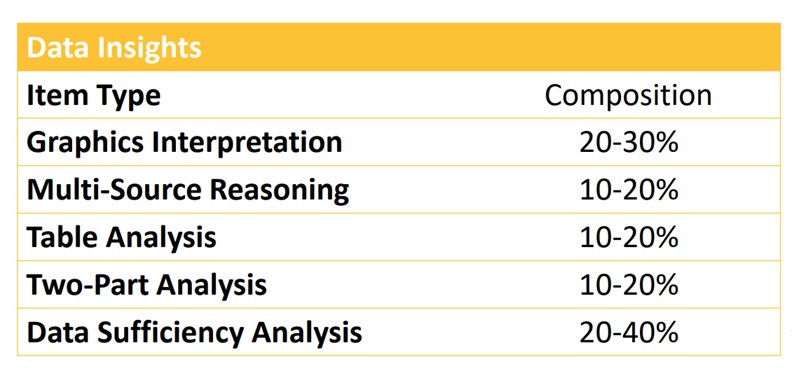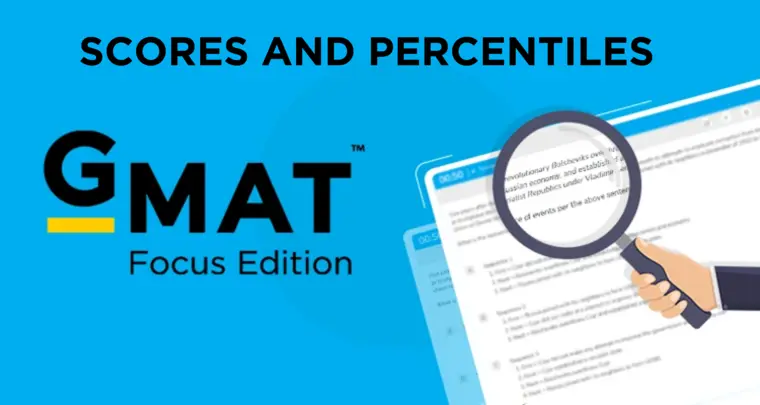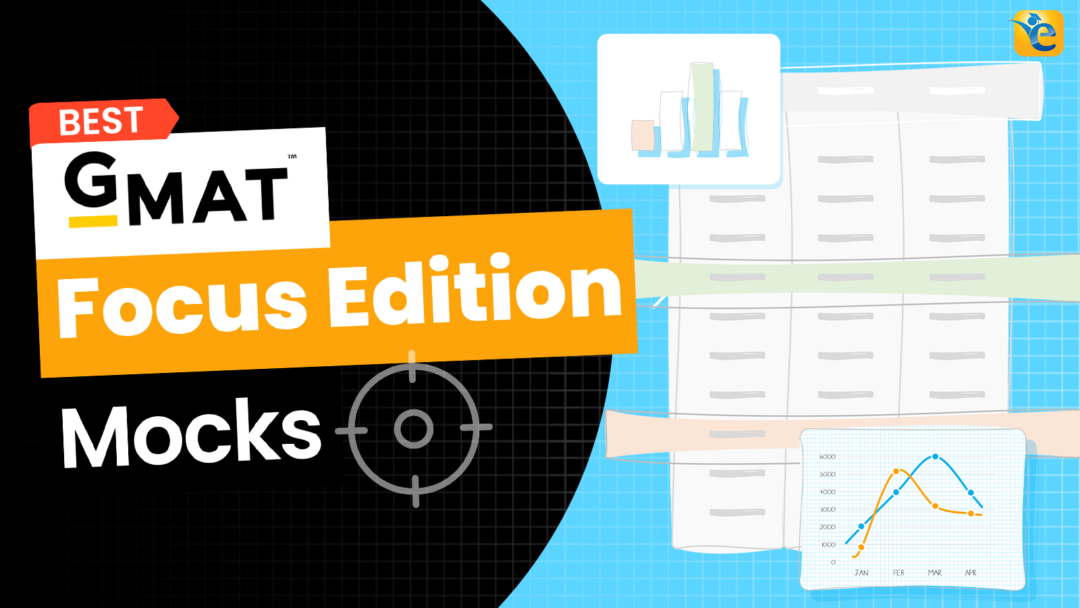Introduction
The Graduate Management Admission Test (GMAT) has long been recognized as a benchmark for admissions into top-tier business programs. In keeping with the evolving dynamics of the business world, the GMAT has been revamped into the GMAT Focus Edition. This new format comprises three main sections – Quantitative, Verbal, and the newly added Data Insights.
In this article, we will delve into the Data Insight section and discuss:
- The importance of the Data Insight section in the New GMAT Focus Edition
- What is the Data insight section and what are its subsection?
- Skills Tested in Data Insight section.
- How to prepare for the Data Insight section and its importance in GMAT scoring.

We invite you to read our GMAT Focus Edition Series Articles, an invaluable resource to keep you at the forefront of your GMAT preparation journey.
Importance of Data Insights in the new GMAT structure
In the new GMAT Focus Edition there are three main sections – Quantitative, Verbal, and the newly added Data Insights.
| New GMAT Sections | No of Questions | Question types | Section duration |
| Verbal Reasoning | 23 | Reading Comprehension, Critical Reasoning | 45 minutes |
| Quantitative Reasoning | 21 | Problem Solving, Algebra and Arithmetic | 45 minutes |
| Data Insights | 20 | Data Sufficiency; Multi-source Reasoning; Table Analysis; Graphics Interpretation; Two-Part Analysis | 45 minutes |
The Data Insights section is not an adjunct; it is an integral part of the exam. The inclusion of this section reflects the increasing importance of data literacy and analytics in the business world.
The section assesses a candidate’s proficiency in interpreting and analyzing various data forms, essential skills in the data-heavy landscape of modern business. By mirroring the rise of data-centric roles in industry and the emphasis on data-intensive subjects in business schools, this section ensures GMAT aligns with contemporary business requirements. Thus, mastery of this section is crucial for candidates to distinguish themselves and demonstrate their preparedness for data-driven business education and career.
Thus, the Data Insights section is not merely an addition to the GMAT; it’s a direct response to the evolving demands of the business world.
Overview of Data Insights Section
Though the term GMAT Data Insights (DI) may appear as a fresh addition, in essence, it amalgamates the elements of Integrated Reasoning and Data Sufficiency from the Quantitative Reasoning section into one consolidated section, known as Data Insights.

The Data Insights section comprises five types of questions: Data Sufficiency, Graphics Interpretation, Table Analysis, Two-Part Analysis, and Multi-Source Reasoning. These questions are designed to test a range of skills, from quantitative reasoning to reading comprehension and critical reasoning.
- Data Sufficiency: Testing quantitative reasoning and data adequacy assessment.
- Graphics Interpretation: Evaluating the ability to read and infer from graphical data.
- Table Analysis: Assessing the capacity to extract relevant information from sortable tables.
- Two-Part Analysis: Probing problem-solving skills through linked questions.
- Multi-Source Reasoning: Evaluating the ability to integrate information from multiple sources.
Did you know 9 out of 10 MBA Admissions decisions are made using a GMAT score? We can give you access to quality online content to prepare for GMAT. We have delivered 10x 700+ scores than the average GMATClub partner. Why don’t you take a free trial and judge it for yourself?
Data Insights Composition on the test
In the GMAT Focus edition, the Data Insights composition is divided into various components. Graphics Interpretation forms 20-30% of the content, while Multi-Source Reasoning, Table Analysis, and Two-Part Analysis each make up 10-20%. Data Sufficiency Analysis is a significant segment, accounting for 20-40% of the composition. This distribution reflects a balanced approach, emphasizing both visual interpretation and logical reasoning skills essential for business management studies.

Source: The GMAC Summit, May 2023
Skills tested in Data Insight Section
The GMAT Data Insights section tests a variety of skills:
1. Data Interpretation and Analysis: It tests your ability to understand, interpret, and analyze complex information from varied sources.
2. Information Synthesis: This skill assesses your capability to combine different data points to create a comprehensive picture and determine the best problem-solving strategy.
3. Analytical Reasoning: Analytical reasoning examines your ability to scrutinize information and arguments and draw logical conclusions from data.
4. Quantitative Reasoning: Despite the lack of complex calculations, quantitative reasoning is key, particularly for understanding and applying quantitative aspects of data.
5. Critical Thinking: This is assessed through questions that require you to evaluate arguments or claims based on the presented data, testing your ability to critically assess information and make sound judgments.
6. Decision Making: This skill is tested through the application of all the above skills to make informed decisions or choices within a complex, data-rich context.
7. Comprehension: This skill is critical for combining textual and visual data effectively.
These skills are crucial not only for the GMAT but also in fields where data interpretation and analysis play key roles.
Data Insights- Question Type
The section comprises 20 questions distributed among five different types, each assessing different facets of data interpretation and analysis.
Let’s discuss each question type:
1) Data Sufficiency Questions (DS):
These questions present you with a mathematical problem and two separate statements labeled (1) and (2). The goal is not necessarily to solve the problem but to determine whether the information given in the statements, either separately or together, is sufficient to solve the problem. DS questions assess your ability to identify the key pieces of information needed to solve a problem and your understanding of the concepts of “sufficient” and “insufficient” data.
We recommend you to read below articles:
2) Graphics Interpretation Questions (GI):
These questions require you to interpret and analyze information presented in a graph or other visual display, such as a scatter plot, x-y graph, bar graph, pie chart, or statistical curve distribution. GIQs challenge your ability to extract relevant information from visual data, draw inferences, identify relationships and patterns, and apply those insights to answer related questions.
Read this article to learn about our Table Analysis and Graphics Interpretation course offerings.
3) Table Analysis Questions (TA):
For these questions, you are given a table of data that you can sort on various columns. A set of statements follows the table, and you have to determine whether each statement is true or false based on the information in the table. TAQs test your ability to analyze and synthesize data from a table, discern patterns or trends, and make accurate statements about the data.
We recommend you to read below articles:
1) Correlation Unveiled: A Tactical Approach to GMAT Table Analysis – Part 1
2) Correlation Unveiled: A Tactical Approach to GMAT Table Analysis – Part 2
4) Two-Part Analysis Questions (TPA):
These questions provide a problem that has two related parts. Your task is to find the correct answer to each part, keeping in mind that the answers are interconnected. The format can be either mathematical or verbal, requiring you to tap into skills such as logical reasoning, text analysis, or quantitative problem-solving.
5) Multi-Source Reasoning Questions (MSR):
MSR questions present you with data from multiple sources, which could be short texts, charts, or tables. These questions require you to effectively analyze, interpret, and integrate information from various sources to solve complex problems. They test your ability to navigate and synthesize multi-faceted information and your aptitude for decision-making based on that information.
Read this article to learn about our Multi-Source Reasoning (MSR) course offerings.
The Data Insights section is designed to mirror real-world data and reasoning challenges, making it an effective way for business schools to assess your readiness for the data-driven decision-making required in modern business environments.
Importance of Data Insights in GMAT Scoring
In the GMAT Focus Edition, the Data Insights section is now as significant as the Quantitative and Verbal sections. Each of these three sections now contributes a third to the total GMAT score. Data Insights score directly contributes to the total GMAT score. A robust performance in this section could significantly improve the total score.
As data becomes increasingly central to business decisions, the skills assessed in the Data Insights section have become more relevant to modern business education.
For a comprehensive understanding of the GMAT Focus Edition’s scoring system, we recommend going through our article “GMAT Focus Edition- Score Chart and Percentiles.” It offers detailed insights into the scoring methodology and percentiles associated with it.
Strategies for Improving Data Insights Score
- Assess Your Starting Point: Take an official mock test to understand your relative percentiles in Data Sufficiency, Graphics Interpretation, Table Analysis, Two-Part Analysis, and Multi-Source Reasoning. This forms the basis of your starting abilities.
- Create a Personalized Study Plan (PSP): Utilize a PSP, which will provide reliable estimates of both the sequence of study and the time needed to excel. By aligning your target DI percentiles with your personalized needs and goals, the PSP offers a precise roadmap to success.
- Targeted Preparation: Begin targeted preparations, starting with areas below the 30th percentile. Focus initially on Table Analysis and Graphic Interpretation, and then progress to Two-Part Analysis and MSR. Emphasize building fundamentals first.
- Cement Your Understanding: After completing each section, ensure to cement your skills. Achieve 55 percent accuracy in hard questions if your target ability is at the 70th percentile. If aiming for the 90th percentile or higher, strive for 70 percent accuracy. For more insights on how to achieve these targets, you may read this Study Plan article.
- Practice with Integrated Tests: Regular practice tests will help gauge how you perform in an integrated manner, ensuring continuous alignment with your overall strategy.
- Analyze Your Performance: Detailed analytics will reveal weak areas that need further concentration, enabling you to fine-tune your efforts.
- Refine and Review: Finally, practice and review concepts in the identified weak areas to reach your target DI score, reinforcing your understanding and confidence.
By employing this refined approach, you’ll be strategically positioned to elevate your Data Insights score on the GMAT Focus edition. A blend of targeted preparation, analytical review, and continuous refinement provides a comprehensive path to your desired success level.
For a comprehensive understanding of how to prepare for the GMAT Focus exam, we encourage you to peruse our article titled “GMAT Focus Study Plan“. This piece offers in-depth insights and strategies to navigate your GMAT Focus exam preparation effectively.
Remember, improving your Data Insights performance isn’t about cramming at the last minute. It’s a gradual process that involves understanding, practice, analysis, and persistence.
Conclusion
In conclusion, the Data Insights section in the GMAT Focus Edition highlights the importance of data interpretation and analysis in today’s business world. This section tests a blend of quantitative, critical reasoning, and integrated reasoning skills, mirroring real-world data-rich scenarios. To ace this, leverage high-quality resources and ensure dedicated preparation. Remember, success in this section not only improves your GMAT score, but also equips you with vital skills for your business education and future career in this data-driven era.
Begin your GMAT preparation with the only GMAT prep company that has delivered the highest success than any other GMAT Club partner. Don’t wait to start your journey towards success. Take our free trial today and discover how we can help you achieve your GMAT goals.












